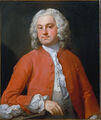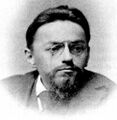Template:Selected anniversaries/October 26: Difference between revisions
No edit summary |
No edit summary |
||
| (12 intermediate revisions by the same user not shown) | |||
| Line 1: | Line 1: | ||
<gallery> | <gallery> | ||
||1689 | || *** DONE: Pics *** | ||
||1689: General Enea Silvio Piccolomini of Austria burns down Skopje to prevent the spread of cholera. He died of cholera himself soon after. Pic: https://commons.wikimedia.org/wiki/File:Enea_Silvio_Piccolomini_Duomo_Siena.jpg | |||
File:William Hogarth.jpg|link=William Hogarth (nonfiction)|1764: Satirist, painter, illustrator, and critic [[William Hogarth (nonfiction)|William Hogarth]] dies. His work ranged from realistic portraiture to comic strip-like series of pictures called "modern moral subjects". | File:William Hogarth.jpg|link=William Hogarth (nonfiction)|1764: Satirist, painter, illustrator, and critic [[William Hogarth (nonfiction)|William Hogarth]] dies. His work ranged from realistic portraiture to comic strip-like series of pictures called "modern moral subjects". | ||
|| | ||1765: Samuel Klingenstierna dies ... mathematician, scientist, and academic. He was instrumental in the invention of the Achromatic Telescope. Pic. | ||
|| | ||1773: Amédée-François Frézier dies ... mathematician, engineer, and explorer. No DOB. Pic. | ||
||1776: Benjamin Franklin departs from America for France on a mission to seek French support for the American Revolution. Pic. | |||
Simon Ritter von Stampfer (26 October 1792 (according to other sources 1790)), in Windisch-Mattrai, Archbishopric of Salzburg today called Matrei in Osttirol, Tyrol – 10 November 1864 in Vienna) was an Austrian mathematician, surveyor and inventor. His most famous invention is that of the stroboscopic disk which has a claim to be the first device to show moving images. | |||
||1817: Aida Yasuaki dies ... mathematician in the Edo period. He made significant contributions to the fields of number theory and geometry, and furthered methods for simplifying continued fractions. Pic. | |||
File:Georg Frobenius.jpg|link=Ferdinand Georg Frobenius (nonfiction)|1849: Mathematician and academic [[Ferdinand Georg Frobenius (nonfiction)|Ferdinand Georg Frobenius]] born. He will make contributions to the theory of elliptic functions, differential equations, and group theory. | File:Georg Frobenius.jpg|link=Ferdinand Georg Frobenius (nonfiction)|1849: Mathematician and academic [[Ferdinand Georg Frobenius (nonfiction)|Ferdinand Georg Frobenius]] born. He will make contributions to the theory of elliptic functions, differential equations, and group theory. | ||
||1874 | ||1874: Martin Lowry born ... chemist and academic. He developed the Brønsted–Lowry acid–base theory simultaneously with and independently of Johannes Nicolaus Brønsted. Pic. | ||
||1911: Shiing-Shen Chern born ... mathematician who made fundamental contributions to differential geometry and topology. He was widely regarded as a leader in geometry and one of the greatest mathematicians of the twentieth century. Pic. | |||
File:Charles Proteus Steinmetz.jpg|link=Charles Proteus Steinmetz (nonfiction)|1923: Mathematician and electrical engineer [[Charles Proteus Steinmetz (nonfiction)|Charles Proteus Steinmetz]] dies. He fostered the development of alternating current, formulating mathematical theories which advanced the expansion of the electric power industry in the United States. | File:Charles Proteus Steinmetz.jpg|link=Charles Proteus Steinmetz (nonfiction)|1923: Mathematician and electrical engineer [[Charles Proteus Steinmetz (nonfiction)|Charles Proteus Steinmetz]] dies. He fostered the development of alternating current, formulating mathematical theories which advanced the expansion of the electric power industry in the United States. | ||
||1930: Walter Feit born ... mathematician who worked in finite group theory and representation theory. Pic. | |||
||1930 | ||1930: Waldemar Haffkine born ... physician and microbiologist. Pic. | ||
||1936 | ||1936: The first electric generator at Hoover Dam goes into full operation. | ||
File:Alexey Krylov 1910s.jpg|link=Aleksey Krylov (nonfiction)|1945: Mathematician and naval engineer [[Aleksey Krylov (nonfiction)|Aleksey Krylov]] dies. Fame came to him in the 1890s, when his pioneering theory of oscillating motions of the ship became internationally known. | File:Alexey Krylov 1910s.jpg|link=Aleksey Krylov (nonfiction)|1945: Mathematician and naval engineer [[Aleksey Krylov (nonfiction)|Aleksey Krylov]] dies. Fame came to him in the 1890s, when his pioneering theory of oscillating motions of the ship became internationally known. | ||
||1957 | ||1957: Gerty Cori dies ... biochemist and physiologist, Nobel Prize laureate. Pic. | ||
||1968 | ||1968: Mathematician Sergei Bernstein dies ... known for contributions to partial differential equations, differential geometry, probability theory, and approximation theory. Pic. | ||
||1968: Soviet cosmonaut Georgy Beregovoy pilots Soyuz 3 into space for a four-day mission. Pic (postage stamp). | |||
||Marcel Gilles Jozef Minnaert | ||1970: Marcel Gilles Jozef Minnaert dies ... astronomer of Belgian origin. He will be a pioneer of solar research, specializing in spectroscopy and the study of stellar atmospheres. Minnaert was also interested in bubbles and musical nature of the sounds made by running water (see Minnaert resonance). Pic. | ||
File:Igor Sikorsky 1914.jpg|link=Igor Sikorsky (nonfiction)|1972: Aircraft designer [[Igor Sikorsky (nonfiction)|Igor Sikorsky]] dies. He pioneered both helicopters and fixed-wing aircraft. | File:Igor Sikorsky 1914.jpg|link=Igor Sikorsky (nonfiction)|1972: Aircraft designer [[Igor Sikorsky (nonfiction)|Igor Sikorsky]] dies. He pioneered both helicopters and fixed-wing aircraft. | ||
File:Henrietta Bolt.jpg|link=Henrietta Bolt|1972: Space pilot and alleged time- | File:Henrietta Bolt.jpg|link=Henrietta Bolt|1972: Space pilot and alleged time-traveler [[Henrietta Bolt]] remembers aircraft engineer [[Igor Sikorsky (nonfiction)|Igor Sikorsky]] as "a genius, and a true friend." | ||
File:Alfred Tarski 1968.jpg|link=Alfred Tarski (nonfiction)|1983: Mathematician and philosopher [[Alfred Tarski (nonfiction)|Alfred Tarski]] dies. He was a prolific author, contributing to model theory, metamathematics, algebraic logic, abstract algebra, topology, geometry, measure theory, mathematical logic, set theory, and analytic philosophy. | File:Alfred Tarski 1968.jpg|link=Alfred Tarski (nonfiction)|1983: Mathematician and philosopher [[Alfred Tarski (nonfiction)|Alfred Tarski]] dies. He was a prolific author, contributing to model theory, metamathematics, algebraic logic, abstract algebra, topology, geometry, measure theory, mathematical logic, set theory, and analytic philosophy. | ||
||Mark Kac | ||1984: Mark Kac dies ... mathematician. His main interest was probability theory. His question, "Can one hear the shape of a drum?" set off research into spectral theory, with the idea of understanding the extent to which the spectrum allows one to read back the geometry. (In the end, the answer was "no", in general.) Pic. | ||
|| | ||1989: Charles J. Pedersen dies ... chemist and academic, Nobel Prize laureate ... best known for describing methods of synthesizing crown ethers. Pic. | ||
| | ||1998: Kenkichi Iwasawa dies ... mathematician and academic ... known for his influence on algebraic number theory. Pic search yes: https://www.google.com/search?q=kenkichi+iwasawa | ||
| | ||2001: The United States passes the USA PATRIOT Act into law. | ||
| | ||2002: Moscow theater hostage crisis: Approximately 50 Chechen terrorists and 150 hostages die when Russian Spetsnaz storm a theater building in Moscow, which had been occupied by the terrorists during a musical performance three days before. | ||
| | ||2007: Arthur Kornberg dies ... biochemist and academic, Nobel Prize. Pic (science!). | ||
| | ||2008: Martin Arthur Pomerantz dies ... physicist who served as Director of the Bartol Research Institute and who had been a leader in developing Antarctic astronomy. Pic search yes: https://www.google.com/search?q=Martin+Arthur+Pomerantz | ||
| | ||2015: Leo Kadanoff dies ... physicist and academic. Pic. | ||
| | ||2015: S. Barry Cooper dies ... mathematician and computability theorist. His book ''Computability Theory'' made the technical research area accessible to a new generation of students. Pic. | ||
</gallery> | </gallery> | ||
Latest revision as of 14:36, 7 February 2022
1764: Satirist, painter, illustrator, and critic William Hogarth dies. His work ranged from realistic portraiture to comic strip-like series of pictures called "modern moral subjects".
1849: Mathematician and academic Ferdinand Georg Frobenius born. He will make contributions to the theory of elliptic functions, differential equations, and group theory.
1923: Mathematician and electrical engineer Charles Proteus Steinmetz dies. He fostered the development of alternating current, formulating mathematical theories which advanced the expansion of the electric power industry in the United States.
1945: Mathematician and naval engineer Aleksey Krylov dies. Fame came to him in the 1890s, when his pioneering theory of oscillating motions of the ship became internationally known.
1972: Aircraft designer Igor Sikorsky dies. He pioneered both helicopters and fixed-wing aircraft.
1972: Space pilot and alleged time-traveler Henrietta Bolt remembers aircraft engineer Igor Sikorsky as "a genius, and a true friend."
1983: Mathematician and philosopher Alfred Tarski dies. He was a prolific author, contributing to model theory, metamathematics, algebraic logic, abstract algebra, topology, geometry, measure theory, mathematical logic, set theory, and analytic philosophy.






